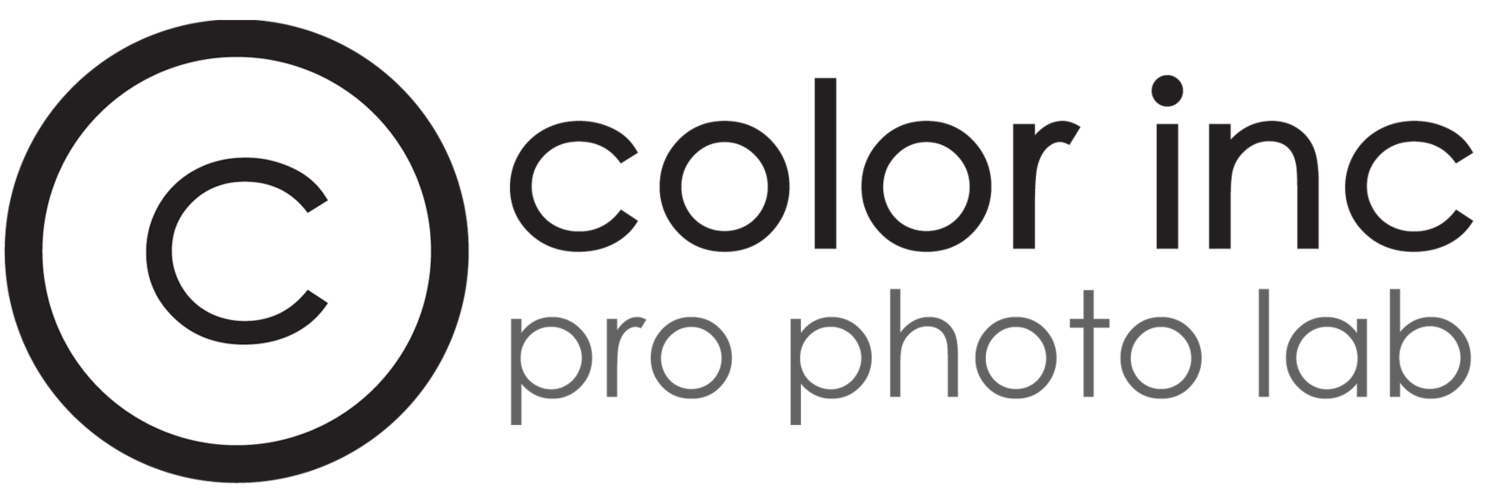Ensure accurate color rendition and brightness by following these steps in your photographic workflow.
1. File management
File Type
JPEG
The "JPEG Interchange Format" is a method of compressing and storing images, and is the native file format for our lab printers. We require this format so that no re-encoding or altering of your image is required to print them.
Color Space
sRGB
At Color Inc, we require all images to be submitted in sRGB color space. Any image not in sRGB color space, may print improperly, with poor color representation.
Image Resolution
300dpi
For example, a 4x6 print should be at least 1200 x 1800 pixels, as 4 inches * 300 pixels/inch = 1200 pixels, and 6 inches * 300 dots/inch = 1800 pixels. Prints larger than 11x14 can be submitted at 240 dpi to expedite file transfer.
Images should have a 1/4" bleed, meaning that you should keep all essential aspects of the image at least 1/4" from the edge of the print. We cannot guarantee that text or image will not be lost outside that border.
File Name
Our system does not properly render images that includes punctuation in the file name or images that have file names longer than 24 characters, including .jpg. Please be sure your file names do not include the words "order" or "border". Do not use any characters other than letters, numbers, underscores and hyphens. For example, any of the following characters would need to be removed from file names: (!@#$%^&*.;:'"[]{}\|<>?,).
2. Color Settings:
Photoshop Color Settings
To edit color settings in Photoshop, click "Edit" -> "Color Settings". Be sure to set "RGB Working Space" to "sRGB IEC61966-2.1". This will set Photoshop to work with files in sRGB. However, this alone does not convert your images to sRGB.
Photoshop can warn you when these settings are not correct, and correct them. In the same Color Setting dialog box locate the Color Management Policies section. Set RGB to “Convert to Working RGB”. Next find the check the boxes labeled "Profile Mismatches" and "Missing Profiles". Make sure the three boxes in this section are checked. This will display a warning anytime you are opening or pasting a non-sRGB image, and offer to convert it for you. You can opt to save these custom settings
Any individual images you are working with that need to be assigned sRGB, click "Edit" -> "Convert to Profile". Then select sRGB (from working profile, or the profile list) and click "Ok". Make sure to "Save As" over the current file.
Lightroom Classic Color Settings
When exporting photos from Lightroom, select JPEG as the image format, sRGB as the color space and set the resolution to 300 pixels per inch.
If you plan to do additional edits in Photoshop after editing in Lightroom, be sure to have your External Editing preferences set.
To adjust this setting, go to the External Editing tab in preferences, and set Color Space to sRGB. Choose a bit depth of 8 bits/component and a resolution of 300. When saving your final edit in Photoshop, be sure to save as a JPEG.
Lightroom CC Color Settings on Export
Lightroom CC has the option to select which color space you want to embed upon export. There are two location locations to find “Export…”. Option one found under the File menu -or- Press the upload icon in the upper right of the CC window as seen below:
Camera Raw Settings
In the initial Camera Raw window there is a color space option at the bottom of the window. Click that to bring up the Camera Raw Preferences window. Select sRGB and press OK. This should save this setting for future use but It’s a good idea to always check that it shows sRGB. Click through the gallery below to view screenshots.
3. Monitor Calibration
For professional photographers, maintaining a calibrated and profiled monitor is essential to attaining consistent and predictable color on all monitors. This user-friendly calibration kit is perfect for ensuring you with the most accurate monitor-to-print color accuracy! The i1Display Pro is the perfect combination of unrivaled color precision, speed and controls for the highest level of on-screen color accuracy.
Match The Target Print to Your Display
View this image in your editing software to evaluate your monitors display compared to the print.
Contact us for a hard copy of the target print.
If necessary adjust your monitor settings manually or with monitor calibrating software.
4. Order Test Prints
Before placing a complete order, we encourage all new customers to order test prints to ensure they are matched to our lab standards for color.
Compare the color and brightness on your screen to the color in the prints. If all the previous steps were done, your prints should look perfect.
Customers can send in 5 individual 8x10 prints to be printed and shipped for 5¢.










